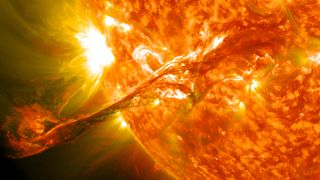Showing posts with label Carrington Event. Show all posts
Showing posts with label Carrington Event. Show all posts
Friday, April 22
A Coronal Mass Ejection From the Sun
Telegraph networks all throughout the globe failed catastrophically on September 1 and 2, 1859. The telegraph operators reported feeling electrical shocks, telegraph paper catching fire, and being able to operate equipment without batteries. The aurora borealis, sometimes known as the northern lights, could be seen as far south as Colombia in the evenings. This phenomenon is typically only seen at higher latitudes, such as in northern Canada, Scandinavia, and Siberia.
The planet was hit by a tremendous geomagnetic storm on that day, which is now known as the Carrington Event. When a massive bubble of superheated gas called plasma is blasted from the sun’s surface and collides with the Earth, it causes these storms. This bubble is called a coronal mass ejection.
The plasma of a coronal mass ejection consists of a cloud of protons and electrons, which are electrically charged particles. When these particles reach the Earth, they interact with the magnetic field that surrounds the planet. This interaction causes the magnetic field to distort and weaken, which in turn leads to the strange behavior of the aurora borealis and other natural phenomena. As an electrical engineer who specializes in the power grid, I study how geomagnetic storms also threaten to cause power and internet outages and how to protect against that.
Geomagnetic storms
The Carrington Event of 1859 is the largest recorded account of a geomagnetic storm, but it is not an isolated event.
Geomagnetic storms have been recorded since the early 19th century, and scientific data from Antarctic ice core samples has shown evidence of an even more massive geomagnetic storm that occurred around A.D. 774, now known as the Miyake Event. That solar flare produced the largest and fastest rise in carbon-14 ever recorded. Geomagnetic storms trigger high amounts of cosmic rays in Earth’s upper atmosphere, which in turn produce carbon-14, a radioactive isotope of carbon. READ MORE...
Monday, September 13
Solar Storms

The sun is always showering Earth with a mist of magnetized particles known as solar wind. For the most part, our planet's magnetic shield blocks this electric wind from doing any real damage to Earth or its inhabitants, instead sending those particles skittering toward the poles and leaving behind a pleasant aurora in their wake.
But sometimes, every century or so, that wind escalates into a full-blown solar storm — and, as new research presented at the SIGCOMM 2021 data communication conference warns, the results of such extreme space weather could be catastrophic to our modern way of life.
In short, a severe solar storm could plunge the world into an "internet apocalypse" that keeps large swaths of society offline for weeks or months at a time, Sangeetha Abdu Jyothi, an assistant professor at the University of California, Irvine, wrote in the new research paper. (The paper has yet to appear in a peer-reviewed journal).
"What really got me thinking about this is that with the pandemic we saw how unprepared the world was. There was no protocol to deal with it effectively, and it's the same with internet resilience," Abdu Jyothi told WIRED. "Our infrastructure is not prepared for a large-scale solar event."
Part of the problem is that extreme solar storms (also called coronal mass ejections) are relatively rare; scientists estimate the probability of an extreme space weather directly impacting Earth to be between 1.6% to 12% per decade, according to Abdu Jyothi's paper.
In recent history, only two such storms have been recorded — one in 1859 and the other in 1921. The earlier incident, known as the Carrington Event, created such a severe geomagnetic disturbance on Earth that telegraph wires burst into flame, and auroras — usually only visible near the planet's poles — were spotted near equatorial Colombia. Smaller storms can also pack a punch; one in March 1989 blacked out the entire Canadian province of Quebec for nine hours. READ MIRE
Subscribe to:
Posts (Atom)
